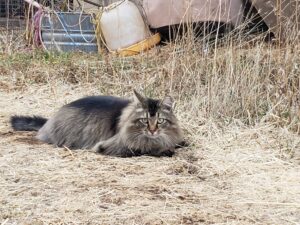 As I walk down my snow covered driveway to retrieve a package left by our gate, I am met by the dotted lines of cat tracks. One meets my path near our garage door, beelines east toward the fence, then abruptly changes direction when it becomes apparent this route will collide with a patch of weeds. The path reminds me of an animated transcription of a bouncing ball. Back and forth this dotted line weaves across the driveway’s deeply inscribed tire tracks all the way to the gate. As I watch these phantom footsteps dance across the driveway, I find myself wondering about the lives of our cats. What do they do with themselves all day and night? Where do they go when they aren’t here? What dangers do they face? With whom else do they interact?
As I walk down my snow covered driveway to retrieve a package left by our gate, I am met by the dotted lines of cat tracks. One meets my path near our garage door, beelines east toward the fence, then abruptly changes direction when it becomes apparent this route will collide with a patch of weeds. The path reminds me of an animated transcription of a bouncing ball. Back and forth this dotted line weaves across the driveway’s deeply inscribed tire tracks all the way to the gate. As I watch these phantom footsteps dance across the driveway, I find myself wondering about the lives of our cats. What do they do with themselves all day and night? Where do they go when they aren’t here? What dangers do they face? With whom else do they interact?
My husband and I hesitated to get the cats initially. I was worried about the birds. One of the things I loved about our house when we first moved in was that after a storm, our front yard would be absolutely filled with robins enjoying the fresh rain. I knew about the dangers of introducing predators into a landscape. I knew that cats were keen hunters and we could be faced with a spate of dead robins after they arrived.
We haven’t found many winged corpses, but we do see far fewer creatures in flight and hear far less chirping outside. The birds no longer build nests in the rafters of our barn, but neither do the mice build nests in the spare livestock bedding we keep there. That was the ultimate tipping point for us—the mice. We had hoped the local snakes would move in to take care of them, but they never did—perhaps the proximity to the house and to the yard where the dogs roam was too much. When the snakes were a bust, we started looking into cats.
Cats who were friendly, social, indoor-dwelling creatures were always off the table for us. Between our dogs who are not the type to snuggle up to a feline housemate and our family members who are strongly allergic, we simply couldn’t accommodate a house cat. Barn cats, on the other hand, are a different animal altogether. Our local shelter, High Country Humane, has a barn cat program in which they identify “feral or stray cats who are happier living independently or prefer to keep their distance from humans” and adopt them out to occupy barns, garages, and warehouses for rodent control. This felt right to us—a program that didn’t encourage breeding, gave a homeless cat a safe place to be, and solved our rodent problem. We hoped the birds would be quick enough and smart enough to stay away.
We knew when we set up a cat-friendly area in our barn that we would probably get some visitors, but we weren’t prepared for the sheer number. We adopted two cats (the shelter recommended getting them in pairs), but at one point there were five regularly taking advantage of the fresh food and water we provided, and a few more who would drop by only occasionally. Over the time we’ve been keeping the cats, we’ve turned over six baby kittens to the shelter. There, they would be immunized, sterilized, and adopted out as either pets or barn cats. We also trapped two adults that we took to the shelter’s trap, neuter, release (or TNR) program and returned them to our property after their surgeries. All of this feels like a net good to me—a way of ensuring that there are fewer cats roaming the neighborhood, reproducing, and putting pressure on the local ecosystem.
We have two permanent residents now who we consider “our cats.” Simmon (named for a character from a book series my husband and I both love) is one of the original pair we brought home from the shelter. His sister vanished years ago, and although I suspect the worst, we like to imagine she just found a better place to hang out. The second cat, Baby, is from the litter of kittens who took up residence in the barn. She escaped our initial capture but we later trapped her as an adult. The name “Baby,” though initially just a descriptor, stuck when I made the connection between her gray fur and Jennifer Gray’s character from Dirty Dancing.
For the most part, we see only glimpses of these creatures. Simmon, the friendlier of the two, stops by around feeding time and plays little games of chase with my husband. Baby makes herself known to us every few days. She enjoys climbing on the roof, especially in the snow, so I see her out my office window from time to time—just wandering. I am, admittedly, jealous of their strolls, their nomadism, and their lack of obligation. These are qualities I used to have, but that have fallen out of my life of late. Whenever I consider leaving my house, I think of all the things that need to be taken care of before I leave and everything I’ll need to do after I come back after I come back. I think about how the other creatures I live with—human and canine—will worry if I spend too long away.
So, for now, I think about the secret lives of these cats and live vicariously through them. I imagine ducking through the gap in the fence and scurrying across the neighbor’s property. I picture myself participating in the particularly harmless voyeurism of being an animal crouching in the weeds unseen, watching people around me go about their lives. I think about what it’s like wandering into the unoccupied parts of this world, sniffing the plants, pouncing on bugs, tracking squirrels and making plans for their capture, and trying to stay out of the way of the coyotes. I picture returning to a place with fresh water and treats where people speak sweetly to me and where I never have to do a moment of housework.

